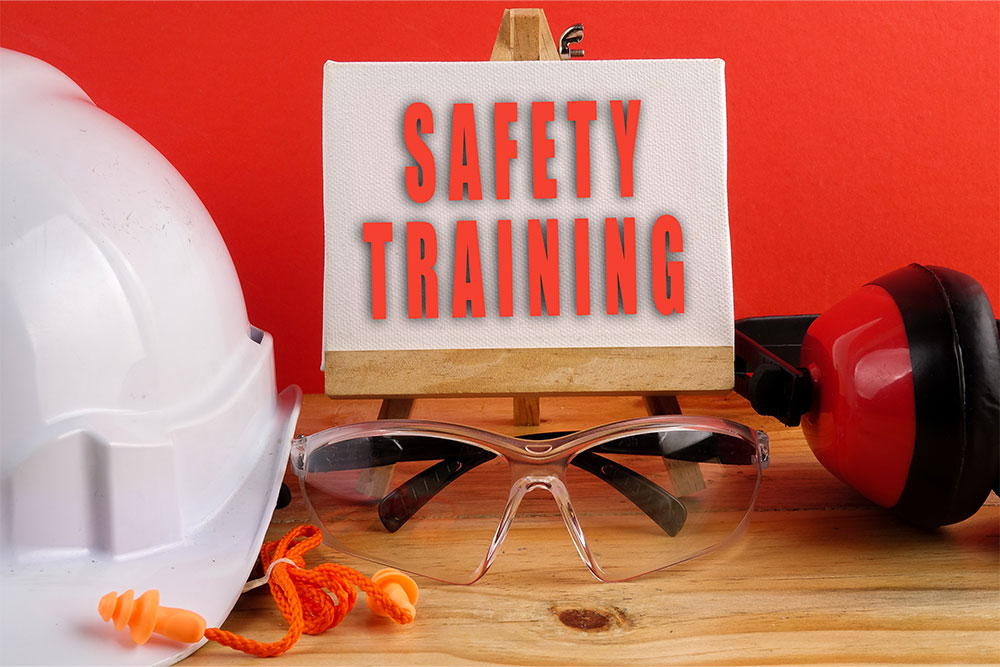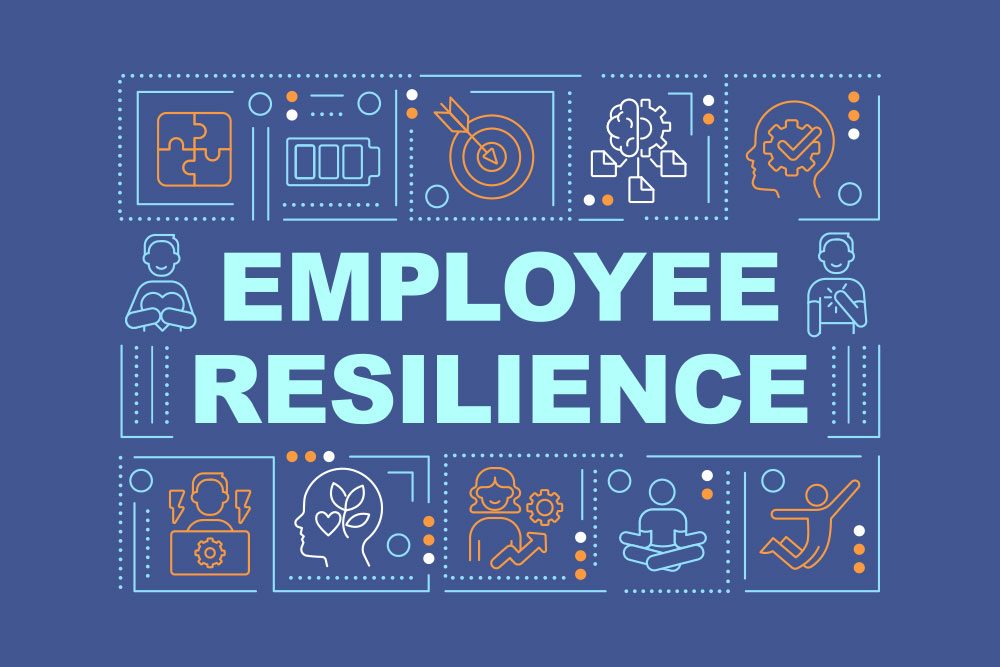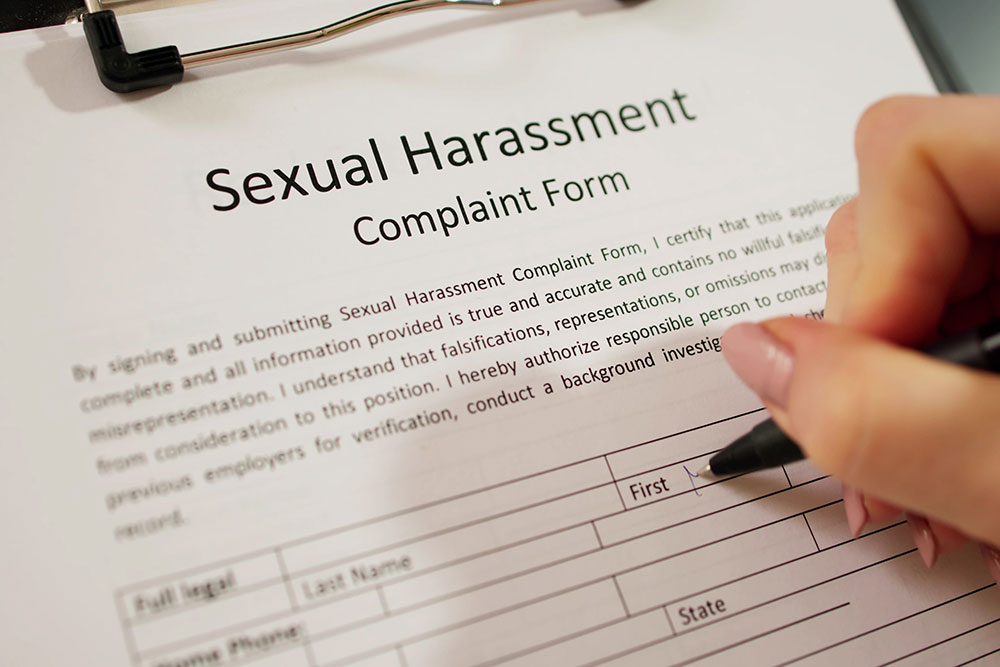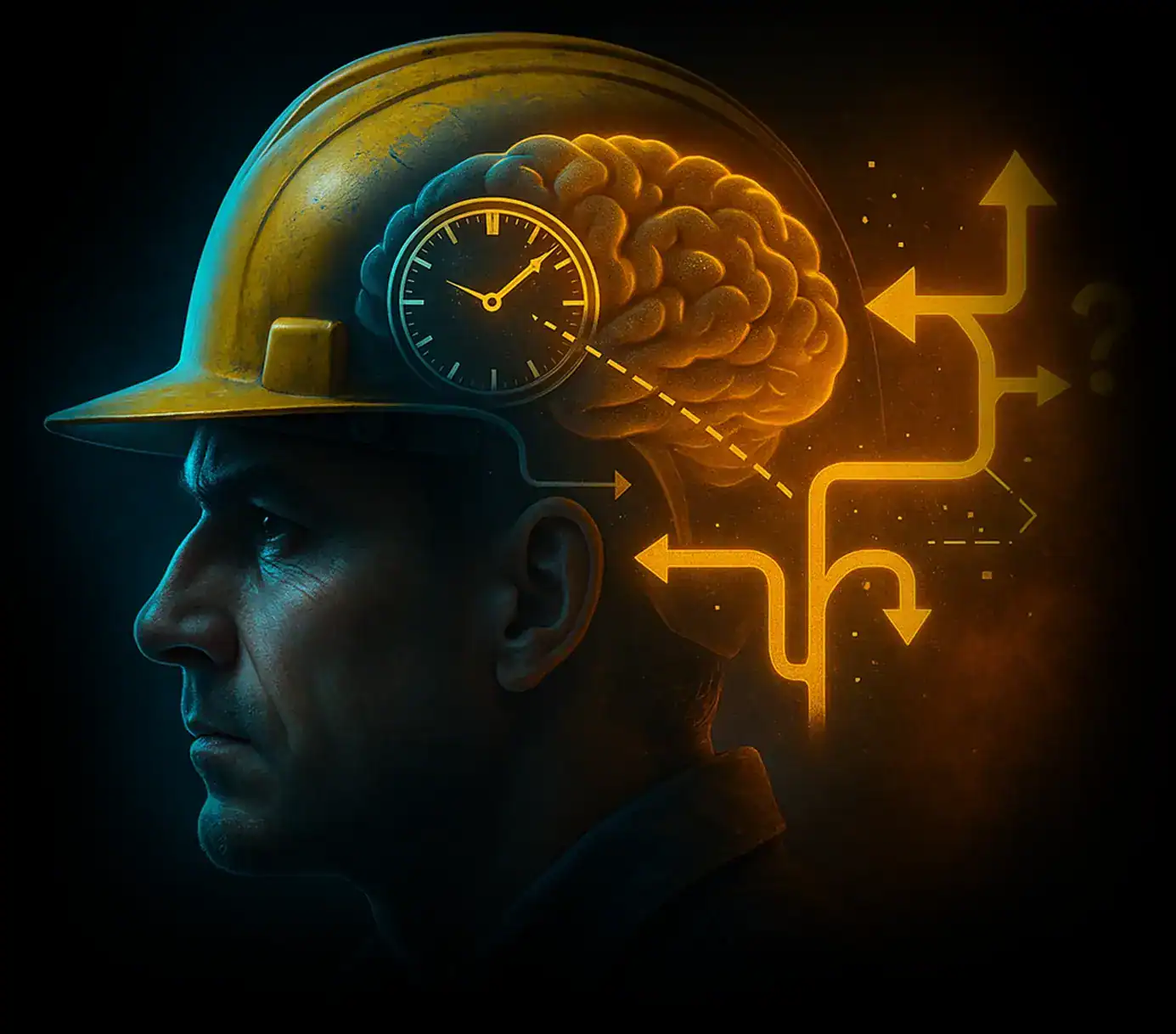
Do you understand what I’m saying? Am I getting through to you? Are we clear? Do you know what I mean?
How often have you heard questions like these? How often have you had to ask them? Aside from being a little pushy, these phrases all indicate problems with communication.
Unfortunately, these situations are all too common. Many of us have never taken the time to think about what good communication is or how to do it.
Fortunately, others have studied communication and established various communication models to help us understand how communication actually works and how we can improve it. This article will delve into these communication models and why they’re so important.
What Is a Communication Model?
Communication models are theories and visual representations that outline how the communication process works. They aim to answer the question: Who says what to whom with what effect? By analysing this, communication theorists develop models that map out the clearest way to communicate.
Using a model helps us communicate our point without confusing or losing the listener.
The concept of communication models isn’t new. People have been working on different communication models since Roman times. In fact, some of these ancient models are still in use today.
How Communication Models Can Help in the Workplace
Have you got a friend who tells long-winded stories? Stories that seem to meander about for ages before getting to the point? Do you ever wish they would say what they want to say quickly and clearly?
Your friend needs to learn an effective communication model.
Clear, concise, and effective communication is crucial in any business setting. Poor communication can turn off customers, slow down productivity or even cause a severe accident.
Giving instructions to a co-worker, discussing a project with a client or ordering from a supplier – all these interactions require you to communicate clearly. If you don’t, you won’t get the outcome you wanted.
Communication models give us the tools to:
- Understand how we’re communicating
- Identify communication issues
- Improve our communication skills
- Develop effective communications frameworks
Communication Skills Training
Our Communication Skills Training courses provide employers, managers and their employees with the fundamental aspects of effective communication for the success of businesses, organisations and individuals. It helps employers build constructive relationships with their workforce.
The Different Communication Models
Although the act of communicating may seem simple, it’s actually quite complicated.
How would you explain the internet to someone from 1850? Now, think about how you would explain your explanation. Not so easy.
After years of research, academics have developed eight different communication models grouped into three categories:
- Linear
- Aristotle’s model
- Laswell’s model
- The Shannon-Weaver model
- Berlo’s S-M-C-R model
- Gerbner’s model
- Interactive
- The Osgood-Schramm model
- Newcomb’s Model
- The Westley and Maclean model
- Transactional
- Barnlund’s transactional model
- Dance’s helical model
We’ll now go through each of the different communication models.
Linear Communication Models
Linear communication is when a message travels in one direction. A sender transmits a message through a channel, and the receivers receive it.
Linear communication isn’t a conversational model. It’s a model used for sending messages to large groups of people.
The main linear linear models include
1. Aristotle’s Model
In 300 BC, Aristotle devised a way to be a more effective communicator. His theory outlines five communication elements:
- The speaker
- The message
- The occasion
- The target audience
- The effect
To communicate more effectively, Aristotle says we should concentrate on three points:
- Ethos – Is the speaker credible?
- Pathos – Is the speaker connected to their audience?
- Logos – Is the message logical? Does it make sense?
Aristotle’s Model – Example:
A senior executive gives a presentation to staff about a new company policy.
- Speaker: The executive
- Message: Explanation of the new policy
- Occasion: Staff town hall
- Target Audience: Company employees
- Effect: Employees understand and follow the new policy
- Ethos: The speaker builds credibility by referring to their track record
- Pathos: The speaker brings up employee concerns
- Logos: The speaker uses clear, appropriate language
2. Laswell’s Model
Laswell’s model refines Aristotle’s initial concept by concentrating on five crucial communication questions:
- Who is conveying the message?
- What message must be conveyed?
- Which channel will be used to convey the message?
- To whom will the message be conveyed?
- What effect will the message have?
Laswell’s Model – Example:
An HR manager sends an internal email announcing a change to the holiday policy.
- Who: HR Manager
- What: Workers now have an additional three days of annual leave
- Channel: Company-wide email
- To Whom: All employees
- Effect: Employees are informed and able to adjust their holiday plans
3. The Shannon-Weaver Model
Shannon and Weaver were American mathematicians who turned away from numbers and devised a new communication model during the Second World War.
The Shannon-Weaver model introduced the idea of ‘noise’. Noise can be anything that disrupts the message, such as static on the radio, a misspelled word, or literal background noise during a speech.
The five components of the Shannon-Weaver model are:
- Sender
- Encoder
- Channel
- Decoder
- Receiver
Shannon-Weaver Model – Example:
A manager is explaining a new process to an employee. During the explanation, a car alarm goes off outside. The alarm distracted the manager, and they skipped a crucial step in the instructions.
In this scenario,
- The manager is the Sender
- Their mouth is the Encoder
- The meeting with the employee is the Channel
- The employee is the Receiver
- Their ears are the Decoder
- The noise is the alarm, which disrupts the message
4. Gerbner’s Model
George argues that communication starts with an event that is perceived by someone who then interprets it and communicates it to others.
The key parts are:
- Event (E): Something happens.
- Perception (M): A person notices the event.
- Means (M’): The person interprets and explains the event.
- Channel (C): The way the explanation is shared.
- Receiver (R): The person or group receiving the message.
- Effect (E’): The outcome after the message is received.
Gerbner’s Model – Example:
A journalist watches a protest in the city.
- Event (E): The protest takes place.
- Perception (M): The journalist sees the protest and forms their own understanding.
- Means (M’): The journalist writes an article about it.
- Channel (C): The article is published online.
- Receiver (R): The public reads the article.
- Effect (E’): Readers form opinions based on the journalist’s account.
5. Berlo’s S-M-C-R Model
Berlo’s model analyses the communication process by concentrating on four steps:
- Source: The communication skills of the sender, including their attitude and culture
- Message: The elements of the message – its content, structure and code
- Channel: The elements of the channel. What senses are used to decode the message? Sight, hearing, touch and so on
- Receiver: The elements of the receiver – their attitude, knowledge and culture
Berlo’s S-M-C-R Model – Example:
A safety officer briefs warehouse workers before the start of their shift.
- Source: The officer’s ability to communicate safety info
- Message: How to lift boxes properly
- Channel: Audible words and a visual demonstration
- Receiver: Workers with varied experience levels. Senior workers are less engaged because they’ve heard the message before.
Interactive Communication Models
The problem with linear communication models is that there’s no room for feedback. Interactive communication models are two-way models where communication is reciprocal.
Examples of interactive models include conversations, email exchanges, or even chats via digital tools. Any communication encounter where there is a back-and-forth between parties can be considered interactive.
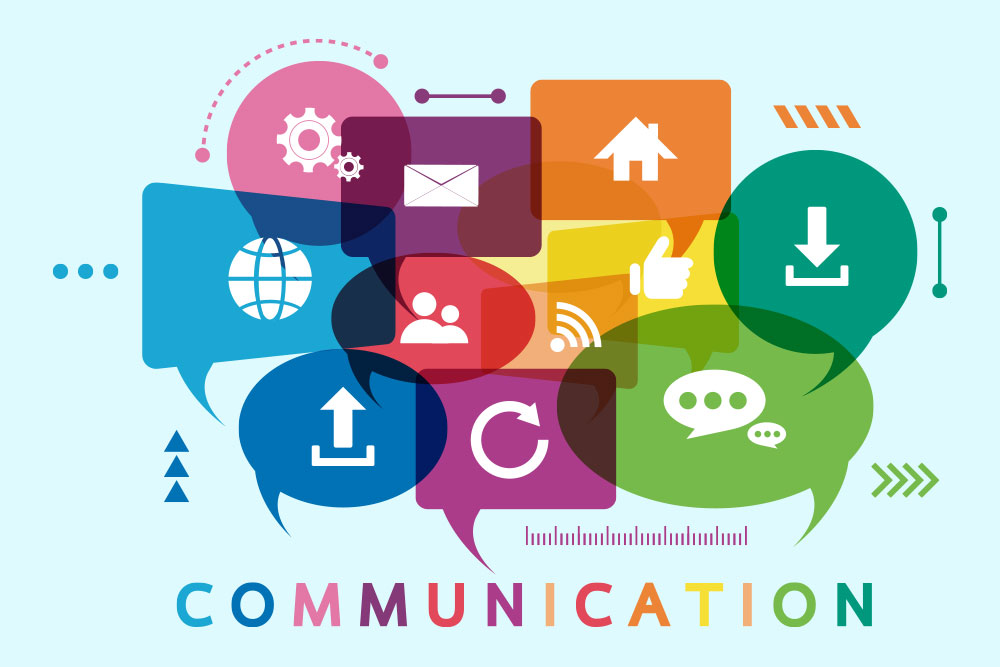
1. The Osgood-Schramm Model
The Osgood-Schramm model analyses communication between two equal parties. It’s useful for looking at any communication involving immediate feedback, such as face-to-face conversations.
There are four elements of communication in the Osgood-Schramm model:
- Circular: Communication is a crucial process between two parties who both interchange roles as senders and receivers
- Equality and Reciprocity: Both parties are equally involved in the process
- Interpretation: The messages relayed must be able to be correctly interpreted and understood
- Three Steps: There are three steps in the communication process: Encoding, decoding and interpreting
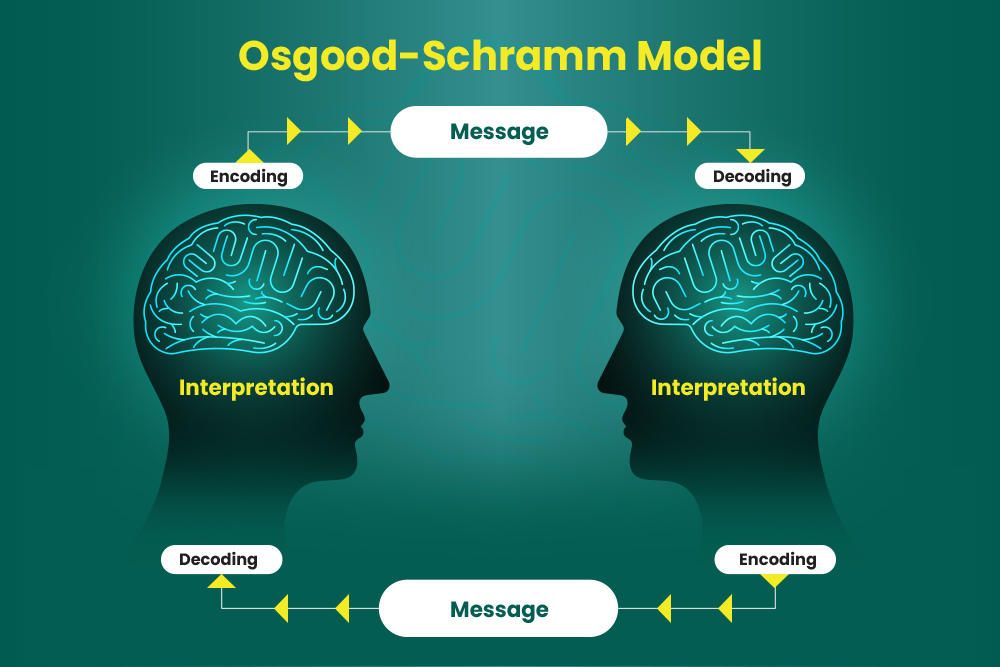
The Osgood-Schramm Model – Example:
Two colleagues discuss how to approach a client project.
- Circular: They take turns speaking, listening and responding
- Equality and Reciprocity: Both bring equal weight to the conversation
- Interpretation: They clarify points to ensure understanding
- Three Steps: At a time, one speaks (encodes), the other listens (decodes) and understands (interprets)
2. Newcomb’s Model
Newcomb’s model focuses on how communication helps maintain social relationships. It views communication as a way to share different opinions about a subject and create a balance of ‘orientations’.
This model has three elements:
- A (Person A)
- B (Person B)
- X (The subject or issue they are communicating about)
The idea is that A and B communicate about X to keep their relationship stable. If they disagree strongly about X, there’s a disequilibrium or strain. If they agree, the have equilibrium. The goal of communication is to reduce strain, improve agreement and create similar attitudes about X.
Newcomb’s Model – Example:
Two friends talk about a political issue.
- A: One friend
- B: The other friend
- X: The political issue
At first they disagree, but as they communicate and share information about what forms their opinion, they start to see things from each other’s perspective. This reduces strain caused by disagreement and improves their relationship.
3. The Westley and Maclean Model
The Westley and Maclean model expands Newcomb’s model to describe large-scale communications. It’s based on the idea that what we say and how we say it is influenced by our backgrounds, personalities, and perspectives.
Elements of this model include:
- Environment – The stimuli of the communication
- Sensory Experience – The experience that provokes communication
- Source/Sender – The person/s sending the message
- The Object of the Orientation of the Source – The Sender’s belief that made them send the message
- Receiver – The person/s receiving the message
- The Object of the Orientation of the Receiver – The beliefs of the person/s receiving the message
- Feedback – How the receiver/s react to the message
- Gatekeepers – Any person/s who has modified or added input to the original message
- Opinion Leaders – Any person/s who can alter the impact of the message
Think of how two groups of rival football fans communicate while watching a match on TV. It’s all based on what environment they’re in, the experience they’re having, their beliefs, their responses, how the commentators explain the match, and what expert commentators have to say.
As one might expect from a football crowd, this kind of communication can get messy. That’s why the Westley and Maclean model is relatively complicated compared to the others.
The Westley and Maclean Model – Example:
A company launches a PR campaign about a new service.
- Environment: Customer expectations in the industry
- Sensory Experience: Customers see an ad
- Source: Marketing manager
- Source Orientation: Belief that the service solves a key issue
- Receiver: Target customers
- Receiver Orientation: Their need for reliability and cost-saving
- Gatekeeper: Media outlet edits the ad for space
- Opinion Leader: Influencer shares and praises the service
The public’s response depends not just on the ad, but on all the surrounding cultural and personal filters.
Transactional Communication Models
Transactional models are a refinement of the concept of interactive models. In these models, the communication itself is viewed as a transaction. It’s a shared process where the communicators create meaning as the communication occurs.
Transactional models stress that the meaning of communication is not simply to convey messages. Communication is used to form relationships, bonds and alliances, and to shape our self-image and our images of others. It concentrates on the context of the communication as much as the way the message is being delivered.
Interactive models picture senders and receivers swapping roles at given times. Transactional models say that we perform these roles simultaneously.
Let’s simplify things. An interactive model might work like this:
Bob says something to Jenny and she responds. Bob then responds.
Using a transactional model Bob says something to Jenny, but she makes a face while he’s saying it, so he realises he’s done something wrong. He might change his message, or he might not. Whether he does so or not might change Jenny’s response. Where they are, what their relationship with each other is, and what their backgrounds are also play important roles.
Transactional models take all these factors into account. They’re complex but are much better at analysing communication.
Barnlund’s Transactional Model
Barnlund’s transactional model centres on the idea that feedback given to the sender acts as the reply for the receiver. Barnlund focused on how private and public cues affect communication. He also looked at environmental factors, nonverbal cues and a person’s thoughts, culture and background.
Barnlund’s transactional model has five main elements:
- The communicators
- Encoding
- The message
- The channel
- Decoding
The Barnlund model can be useful when analysing face-to-face conversations, email exchanges or online chats. It’s especially good at examining how cultural differences cause misunderstandings.
Barnlund’s Transactional Model – Example:
Two engineers from different countries are discussing a design issue over a video call.
- Communicators: Both engineers are speaking, listening, reacting, and interpreting messages at the same time
- Encoding: One engineer uses technical terms and gestures while explaining
- Channel: Video call – using voice, facial expressions, and screen sharing
- Decoding: The other engineer listens, watches the screen, and interprets based on their own knowledge and cultural background. One engineer uses an idiom: the equipment has “kicked the bucket”.
- The other engineer misunderstands because the idiomatic phrase doesn’t exist in their culture. A pause, followed by a puzzled expression, prompts the first engineer to rephrase. They both adjust how they speak and clarify terms.
- Outcome: They eventually reach a shared understanding, but only after noting nonverbal feedback and adjusting their language.
Dance’s Helical Model
According to Dance’s helical model, communication is circular in nature and becomes increasingly complicated as it progresses. Dance pictures communication as a spiral that never loops back on itself. At each stage, we receive feedback that influences what our next contribution will be.
As our knowledge expands, the circles in the communication spiral get wider and wider. Each spiral represents new stages, as no form of communication perfectly repeats itself.
Dance’s Helical Model – Example:
A new employee slowly becomes more confident in meetings over several weeks.
- In their first meeting, they speak briefly and cautiously
- In the next meeting, they give a short report
- Later, they lead a discussion
Each interaction builds on the last. Their understanding, confidence and skill in communicating grow over time, never returning to the same point.
How to Improve Your Communication Skills
Poor communication skills can impede the success of your business. If you’re not communicating well, you could lose out on a big project, not get the best deal from your suppliers, have a marketing campaign flop or confuse your staff with unclear instructions.
This all adds up to lost business, lost time and lost money.
Our Communication Skills Training will give you and your team the skills to communicate clearly in the workplace. You’ll learn how to become a better listener and how to use your words and body language to convey your messages more decisively.


